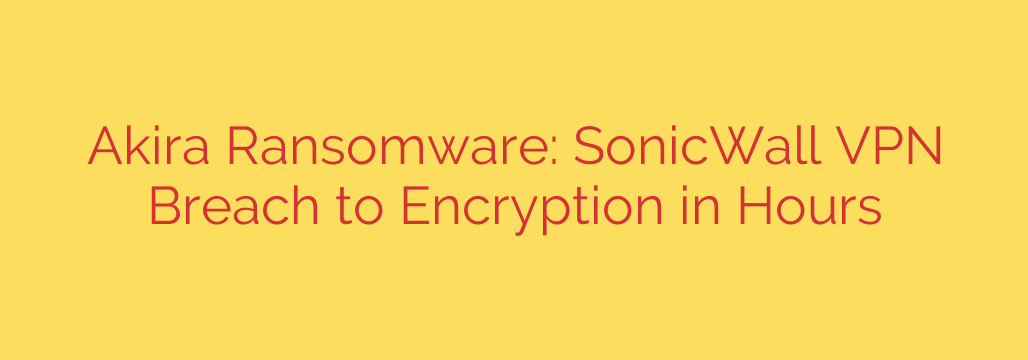
Akira Ransomware Strikes: Unpatched SonicWall VPNs Lead to Rapid Network Encryption
In the world of cybersecurity, attackers often move with alarming speed. A recent wave of attacks by the Akira ransomware group demonstrates just how quickly a minor security gap can escalate into a full-blown crisis. Cybercriminals are now actively exploiting known vulnerabilities in SonicWall Secure Mobile Access (SMA) appliances, moving from initial breach to complete network encryption in a matter of hours.
The primary target of these attacks are organizations using SonicWall SMA 100 series appliances that have not been properly patched and, crucially, do not have multi-factor authentication (MFA) enabled. This combination creates a perfect storm, allowing threat actors to gain an initial foothold with alarming ease.
The Entry Point: Exploiting a Known Vulnerability
The attack begins by targeting user accounts on SonicWall VPNs that are secured only with a single password. Without the critical second layer of security provided by MFA, attackers who have acquired legitimate credentials—whether through phishing, password spraying, or other means—can simply log in and gain access to the corporate network.
Once inside, the clock starts ticking. The Akira operators have refined their attack methodology to be ruthlessly efficient, aiming to cause maximum disruption before security teams can mount an effective response.
Anatomy of a High-Speed Akira Attack
After gaining initial access through the compromised VPN account, the attackers follow a swift and deliberate playbook to take control of the environment.
Reconnaissance and Credential Theft: The first step is to map the network and escalate privileges. Attackers often use powerful tools like Mimikatz to harvest additional credentials, including high-level administrator accounts, directly from the system’s memory.
Lateral Movement: With elevated credentials in hand, the threat actors move laterally across the network. They often utilize legitimate remote access tools like AnyDesk or the built-in Remote Desktop Protocol (RDP) to connect to critical servers, file shares, and domain controllers, blending in with normal administrative activity to avoid detection.
Data Exfiltration: Before deploying the ransomware, Akira operators engage in double extortion. They identify and steal sensitive corporate data, uploading it to their own servers. This stolen data is later used as leverage, with the threat of public release if the ransom is not paid.
Final Encryption: In the final stage, the ransomware payload is executed. The attackers deploy the Akira encryptor across all accessible devices, locking critical files and appending a
.akiraextension. This devastating final step can bring business operations to a complete standstill, often occurring just a few hours after the initial breach.
Urgent Security Measures to Defend Against Akira Ransomware
The speed and methodology of these attacks underscore the importance of proactive, layered security. Organizations can take immediate steps to defend against this threat and significantly strengthen their security posture.
Mandate Multi-Factor Authentication (MFA): This is the single most effective defense against this specific attack vector. Enforcing MFA on all VPN access points and other external-facing services ensures that a compromised password alone is not enough for an attacker to gain entry.
Patch and Update Immediately: The vulnerabilities in SonicWall devices are well-documented. Ensure that all network appliances, especially VPNs and firewalls, are running the latest firmware and have all security patches applied without delay.
Implement the Principle of Least Privilege: User accounts should only have access to the data and systems absolutely necessary for their roles. This practice, known as the principle of least privilege, contains the potential damage an attacker can do with a compromised account.
Strengthen Network Monitoring: Deploy robust endpoint detection and response (EDR) solutions. These tools can help detect suspicious activity, such as the use of credential-dumping tools or unauthorized remote access software, providing an early warning of an intrusion.
Maintain and Test Backups: In a ransomware attack, reliable backups are your last line of defense. Ensure you have immutable, offline backups of all critical data. Regularly test your backup restoration process to confirm you can recover quickly and effectively in an emergency.
The rise of rapid-fire attacks like those from the Akira group serves as a stark reminder that foundational security practices are non-negotiable. By prioritizing MFA, consistent patching, and a defense-in-depth strategy, organizations can close the critical gaps that cybercriminals are so eager to exploit.
Source: https://www.helpnetsecurity.com/2025/09/29/akira-ransomware-sonicwall-vpn/








